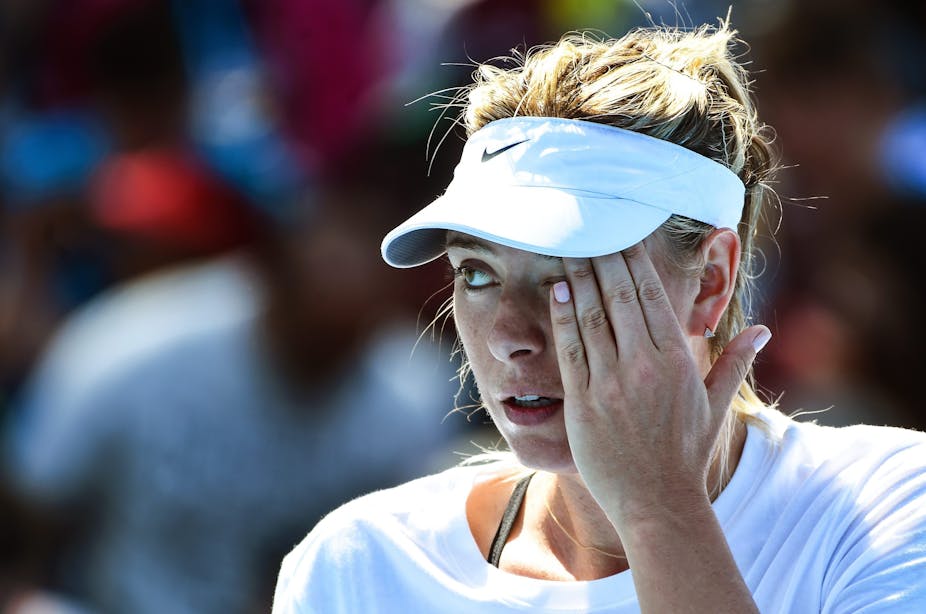Tennis star Maria Sharapova has admitted taking the banned drug meldonium.
Sharapova is an experienced professional. Strict liability applies. She doped. The more interesting question is: why was meldonium (also known as mildronate) placed on the banned list?
The World Anti-Doping Agency (WADA) bans drugs that are either unsafe, performance-enhancing, or against the spirit of sport – or some combination of these.
Is meldonium unsafe? I have not gone into the safety profile in detail. But the question itself is not simple. How safe is too unsafe for a competent adult athlete to consent to before we need to create a blanket ban?
If we compare it to other practices that are permitted there would be a fairly wide scope for safety: ordinary sporting practices such as rugby, horse riding and football carry a risk of quadriplegia, for example.
Perhaps the safety bar for drugs should be lower. But even narrowed down to drugs, safety is applied inconsistently. Caffeine used to be on the prohibited list but was removed in 2004. Caffeine is a performance enhancer. It increases time to exhaustion in endurance athletes.
So, was caffeine removed from the prohibited list because although it is an enhancer, it is safe? There have been a number of deaths or near–misses reported worldwide with caffeine as a primary or contributory factor.
So, what is the difference between caffeine and other drugs?
I believe the answer lies partly in our broader values: we have a “nature bias”. Why is alcohol, one of the most harmful and addictive substances we consume, legal, yet we have recently banned any and every other psychoactive substance regardless of their harms or benefits?
In part, at least, caffeine and alcohol are so widely socially and legally accepted because they occur naturally, and are therefore seen as inherently safe. The poisonous subtext is that only the weak or greedy get addicted or hurt themselves.
Meldonium and other new drugs are seen as artificial – and therefore inherently dangerous at any dose even to us strong-minded folk.
This seems to be the basis for WADA’s approach to regulating how the oxygen-carrying capacity of blood is lifted by increasing haematocrit, a measure of how much of our blood is made up of cells. For example, injecting the hormone erythropoietin (more commonly known as EPO) unnaturally increases haematocrit and so is banned. But hypoxic air tents and altitude training both stimulate the body to naturally produce haematocrit, yet they are allowed.
So, although this is not stated, a hidden clause in WADA’s code is that something will be banned if it is both performance-enhancing and artificial, either in preparation or delivery.
“Natural” performance enhancers like creatine, beetroot extract or caffeine are not banned. You can even purify these and dramatically increase their intensity – and in some cases their risks – in a pill form. But as long as you could take them naturally in your dinner, they are allowed.
The natural/artificial distinction is important to ordinary moral thought.
Nature sells. “All natural” was the second-most-used claim on new American products in 2008, and the single most popular with purchasers. Despite being difficult to define, nature bias is used to advertise food, cosmetics, supplements and cleaning products as “100% natural”. As former WADA chair Dick Pound has said with doping:
It’s like they used to say about pornography. You know it when you see it.
But nature is itself a series of chemicals and chemical reactions. To be sure, artificial constructs often have greater risks and unpredictable effects. But it is the effects that matter, not the means of achieving them. Neither natural nor unnatural substances should be taken without first investigating their safety.
The nature bias is behind the “playing God” objection to new technologies. We make a mess when we interfere in nature. Sometimes this is true, but over time we have reaped enormous benefits from our interference. Smallpox, one of the greatest killers, was eradicated by vaccination.
Anti-vaxxers today have an extreme form of nature bias. One “anti-vax” website lists at number two in the list of “reasons” against vaccination:
ALL vaccines are loaded with chemicals and other poisons.
Chemical here is synonymous with poison.
The distinction made in the sporting rules for drugs appears to go beyond safety and to moral grounds. But what moral difference does it make whether something is natural or artificial? Outside of drugs, sport is full of artificial enhancers: running shoes are artificial, aero helmets are artificial, chlorinated swimming pools are unnatural.
Instead of taking an intuitive approach of “knowing it when we see it”, we should ban substances or practices that are clearly or probably unsafe. And we should ban specific substances that corrupt the spirit of a particular sport – that is, that substantially reduce the human element, on a sport-by-sport basis.
That means removing the nature bias. Nature bias does not track harm. Heroin is a natural substance: it derives from the poppy. The humble – and natural – potato can (rarely) cause so–called “potato poisoning” due to solanine, which is present naturally at variable levels.
Nor does nature bias track whether a product removes or substantially reduces the human element of a particular sport. Sharapova’s skill, co-ordination and dedication remain as intact whether she took beetroot supplement or meldonium to gain an advantage. The distinction simply appeals to our intuitions.
The nature bias may be partly behind the ever-growing list of banned substances. It can cause us to form irrational policies or engage in irrational practices. It can even be lethal.
Steve Jobs suffered from a form of pancreatic cancer that was initially curable by modern medicine. He chose natural therapies instead. By the time he realised this was a mistake, it was too late.
Further reading: Maria Sharapova’s positive drug test: what is it and what does it mean for her?

